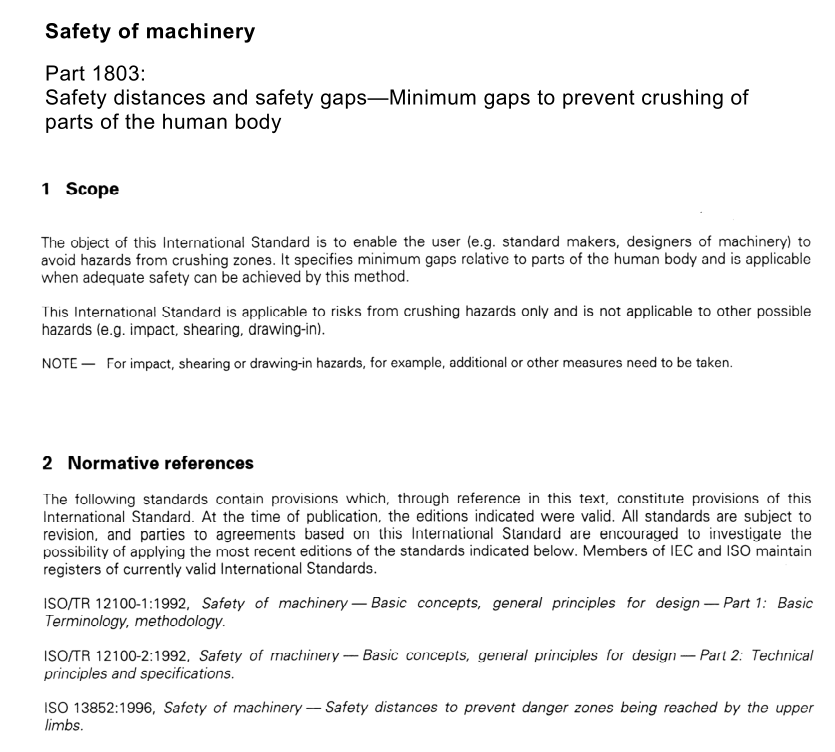AS NZS 4024.1803 pdf download – Safety of machinery Part 1803: Safety distances and safety gaps—Minimum gaps to prevent crushing of parts of the human body

AS NZS 4024.1803 pdf download – Safety of machinery Part 1803: Safety distances and safety gaps—Minimum gaps to prevent crushing of parts of the human body
1Scope
The object of this International Standard is to enable the user (e.g.standard makers, designers of machinery) toavoid hazards from crushing zones. lt specifies minimum gaps relative to parts of the human body and is applicablewhen adequate safety can be achieved by this method.
This International Standard is applicable to risks from crushing hazards only and is not applicable to other possiblehazards (e.g. impact, shearing. drawing-in).
NOTE一 For impact, shearing or drawing-in hazards, for example, additional or other measures need to be taken.
2Normative references
The following standards contain provisions which, through reference in this text,constitute provisions of thisInternational Standard.At the time of publication, the editions indicated were valid.All standards are subject torevision. and parties to agreements based on this International Slandard are encouraqed to investiuate thepossibility of applying the most recent editions of the standards indicated below.Members of lEC and lS0 maintainregisters of currently valid lnternational Standards.
ISO/TR 12100-1:1992,Safety of machinery — Basic concepts,general principles for design — Part 1: BasicTerminology, methodology.
ISO/TR 12100-2:1992,Safety of macthinery -— Basic concepts,gerneral principles fur design 一Pat 2.Tectnicalprinciples and specifications.
ISO 13852:1996,Safcty of machinery — Safety distances to prevent danger zones being reached by the upperlimbs.
3Definitions
For the purposes of this International Standard, the definitions given in ISOTR 12100-1 and lS0 13852 and thefollowing definition apply.
3.1 crushing zone:Zone in which the human body or parts of the human body are exposed to a crushing hazard.This hazard will bc gcneratcd if
-two movable parts are moving towards one another, or-one Imovable part is rmoving towards a fixed part.
NOTE – Seo also anncx A.
Minimum gaps
4.1 Methodology for the use of this International Standard
The method of using this International Standard shall form part of the iterative safety strategy outlined in clause 5″Strategy for selecting safety measures” of lSO/TR 12100-1:1992.
The user of this International Standard shall:
a)identify the crushing hazards;
b) assess the risks from these hazards in accordance with lSO/TR 12100-1,paying particular attention to the
following:
– where it is foreseeable that the risk from a crushing hazard involves different parts of the hodty, the
rminimum gap given in table 1 relating to the largest of these parts shall be applied lsee also dl.
the unpredictable behaviour of children and their body dimensions if children are included in the populationat risk,
whether parts of the body could enter the crushing zone in a configuration other than those indicated intable 1,
whether thick or bulky clothing (e.g. protective clathing for extreme temperatures) or tools have to be takeninto account.
whether machinery will be used by persons wearing thick-soled footwear (e.g. clogs) which will increase theeffective dimension of the foot;
c)select from table 1 the appropriate minimum gap relating to the body part at risk (see also annex A);
dif adequate safety cannot be achieved by the minimum gaps selected from table 1, other or additionalmeasures and/or means shall be used (see e.g.ISO/TR 12100-1, ISO/TR 12100-2 and lS0 13852).
lf the minimum gap for the largest expected body part cannot be achieved, the following example gives oneparticular means of restricting access to smaller body parts.
EXAMPLE
Access of larger body parls to the crushing zone can be prevented by the use of protective structures havinga restricted opening, as indicated in figure 1.
The possibility of access to a crushing zone for a particular part of the body is dopendant on the following the gap a hetween the fixed and moving part or between two moving parts;
the depth b of the crushing zone:









